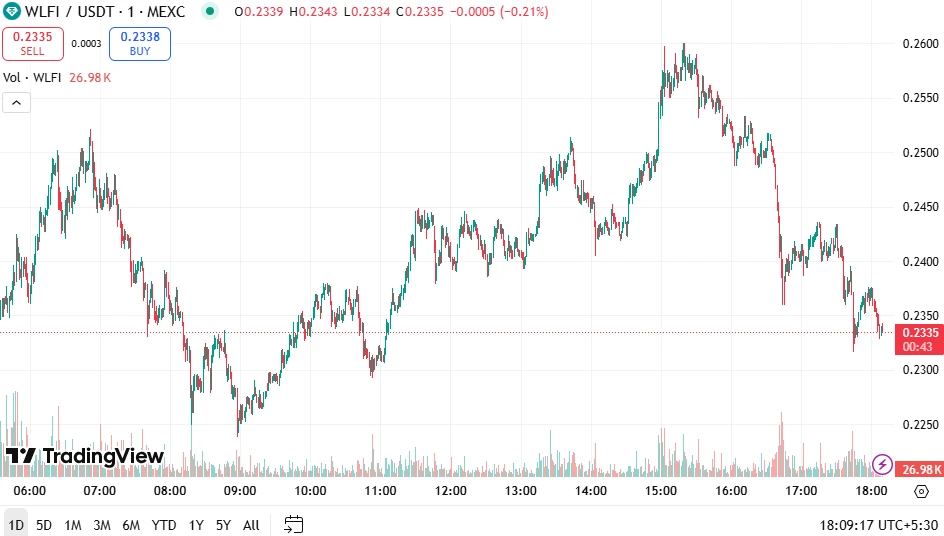The massive growth of the WLFI token has created a lucrative opportunity for scammers, who are using clone tokens and other means to trick users. As the Trump family’s profit after the launch of the WLFI token soars to $6 billion, scammers are increasingly exploiting this hype. Creating fake tokens that mimic World Financial Liberty’s original cryptocurrency, illicit players are capitalizing on WLFI’s success, deceiving investors to drain their wallets.
Trump Family Banks $6B
Interestingly, WLFI, the cryptocurrency tied to World Liberty Financial, a crypto project backed by the Trump family, began trading on September 1, with an initial price of over $0.30. With a total supply of 100 billion coins, it implied a fully diluted valuation of $30 billion.
Following this debut, the Trump family’s crypto wealth skyrocketed to about $6.5 billion on paper, representing a $4.5 billion increase from the WLFI coin’s presale value of $0.05. Then, the family’s allocation was worth around $1.1 billion.
As per the project website, the Trump family’s WLFI holdings are substantial. It consists of 22.5 billion WLFI tokens, equivalent to 22.5% of the total 100 billion supply. The family also holds a 38% equity stake in the corporate parent, WLF Holdco LLC, and 75% of the net revenues from presales.
Fake Tokens Surge
Capitalizing on the Trump family’s massive crypto profits, scammers are launching more and more clone tokens, imitating the real WLFI coin. The increased attention surrounding the crypto market has led to a proliferation of scam tokens, with many projects emerging on social media.
In a recent X post, Bubblemaps, a prominent data visualization platform, drew the community’s attention to “bundled clones.” These are smart contracts designed to mirror the official WLFI code. The “bundled clones” are reportedly spreading rapidly and putting investors at risk.
As these scam tokens use similar names, branding, and addresses, the community could be easily manipulated into investing in worthless copycats. Unlike traditional financial markets, crypto transactions offer limited recourse for investors for their mistakes. This makes them vulnerable to significant financial losses. Addressing this increased vulnerability, Bubblemaps cautioned investors, saying, “Be careful what you buy.”
Token Holders Targeted in Phishing Scam
In addition to clone tokens, WLFI investors are currently facing another wave of scams, as phishing attackers target token holders. Leveraging Ethereum’s EIP-7702 upgrade, these scammers are using a known phishing wallet exploit.
As pointed out by SlowMist Founder Yu Xian, the exploit takes advantage of a new functionality introduced by Ethereum’s Pectra upgrade. This allows external accounts to temporarily act like smart contract wallets, enabling features like delegated execution rights and batch transactions.
According to Xian, hackers are exploiting Ethereum’s EIP-7702 upgrade to embed malicious addresses in victim wallets. When a deposit is made, the hackers swiftly drain the tokens, with the WLFI token holders being the most targeted. The X post read,
“Encountered another player whose multiple addresses’ WLFI were all stolen. Looking at the theft method, it’s again the exploitation of the 7702 delegate malicious contract, with the prerequisite being private key leakage.”
WLFI Coin Price Dips
Although the token traded around $0.30 immediately after the launch, it saw a significant decline on the same day. Now, WLFI coin is valued at $0.2356, marking a notable dip of 25% over the last 24 hours.

Despite the increasing copycats and phishing scams, traders remain optimistic about the crypt, which is reflected in the colossal surge in trading volume. Over the past 24 hours, the volume has surged by 6388%, hitting $5.13 billion. With a market cap of $5.85 billion, the token is ranked 26th on CoinMarketCap.
Amidst this backdrop, investors and traders are urged to exercise caution before taking on decision on WLFI tokens.



